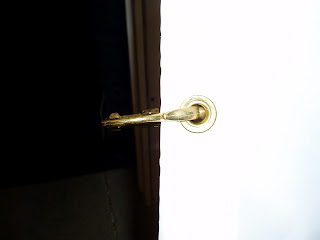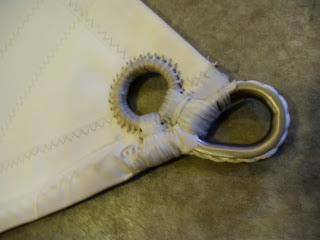I finished the staysail today. I didn't keep track, but I figure somewhere around 30 hours to complete. About 3 times faster than I had originally thought before I started all this. Of course, having never sewn a sail before, I didn't have a valid frame of reference. It was however, a blast. I really enjoyed it, and I am hoping to start the mainsail tomorrow. I think I will try and keep track of the number of hours I it takes me. The only real problem is that I am now a seasoned sailmaker, and it will not be a true example of how long it takes for a rank amateur to complete a project of this type. Oh well, I'm over it....
A few posts back I wrote about making my new sewing palms. Emilian Marino in his book said that you needed two palms. A seaming palm and a roping palm, but to be honest, I really didn't see the need for the roping palm; until now. I was using the seaming palm to do the hand sewing, but my hand was getting sore pulling on the wax twine. Then I remembered that the roping palm had the added piece on the thumb to provide support for putting some good pressure on the twine. It took a bit, but totally by accident I started using it the way it is supposed to be used, (I think), and I got through the whole sail without and pain in my hand. So, I change my previous statement of, "you can't sew a sail without a palm", to, "someone would be insane to try and sew a sail without a roping palm."
Here is a picture of reefing grommet on the luff. There was nothing in the instructions about adding chafe protection for the reefing grommets, and I didn't think of it until after I had installed the two on the luff. Luckily, the luff has the least amount of chafe. It is attached with a large shackle, and it doesn't move around much. Mind you I couldn't leave it like this, so I had to come up with something.
Here is the leather rapped tack.
This is what the head looked like before the leather chafe protection covered it up.
This is one of the two leech reef points. These ones are subject to a lot of bashing around. Stays, shrouds, stuff on deck, life lines, etc.... Its always moving around, so it needs some good chafe protection. I got the idea for this one out of Emiliano's book. He recommended covering the whole grommet with leather prior to putting the thimble in, but there wasn't enough room for the thimble. So I had to go half way with the leather, and then put a second piece on the backside, over-top. It should work nicely. The head after being rapped with leather.
My answer for the luff reef points. The leather protects the edge of the sail, and boltrope. There isn't a lot of chafe problems here, as mentioned before, but this will take care of the sensitive areas, and I didn't have to cut out the thimble and do it all over again.And the clew attachment, finished. There are three separate pieces of leather on this to protect the stitching. The directions didn't call for it, but Emiliano's book recommended this setup. It made sense to me, so I went ahead and did it. There was lots of extra leather, so what the hey...
Crappy picture, but the spur gromments were installed as the directions indicated, and the snaps were put into place. There was no chafe protection for the snaps, like the usual little pieces of plastic, but these are easy to remove, and if I notice any chafe, I'll have to put something in between the snaps and the boltrope.
I couldn't get a picture of the whole sail, so here are a collection of shots showing the finished sail.
And lastly the Sailrite logo. Its a sick on, and it is supposed to stay put. In the videos on their website they always sew them on as well, maybe I will later, who knows.
All done. One of the gentlemen in my yacht club warned me about attempting to make my own sails, saying that I had better leave it to the experts. Kind of like mortals messing about in the world of the gods. But I have to say, this was really quite easy, especially considering it was my first time. I will admit though, that if I had to design the sail, and cut out all the panels, it would have taken a lot longer, and the results would not have been anywhere near as good.
The true test of course will be out in the big tank. Now if this wintry stuff will go away so the boat can go in the water, and the mast up, we can try out this new sail.
Fair winds...






































.JPG)